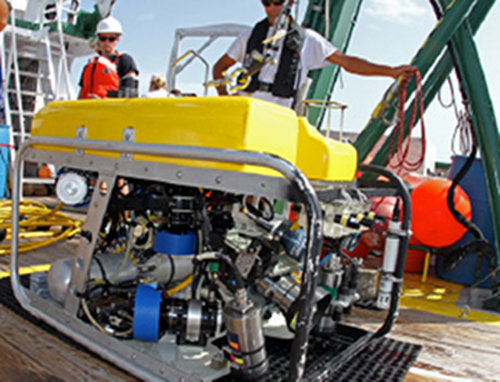
A key purpose of NOAA’s Office of Ocean Exploration and Research is to investigate the more than 95 percent of Earth’s underwater world that until now has remained virtually unknown and unseen. Such exploration may reveal clues to the origin of life on Earth, cures for human diseases, answers on how to achieve sustainable use of resources, links to our maritime history, and information to protect endangered species.
In 2011, NOAA’s National Centers for Coastal Ocean Science’s Center for Sponsored Coastal Ocean Research began a five-year project to investigate the role that the reefs of Pulley Ridge in the Gulf of Mexico may play in replenishing key fish species and other organisms in the downstream reefs. The Coral Ecosystem Connectivity 2015 Expedition is the final year of this interdisciplinary study. The 2013 and 2014 expeditions can be explored online. Results from this project will be used by resource managers to help manage and protect shallow and mesophotic coral ecosystems.
Most people are familiar with shallow water and deep-sea coral ecosystems, but ocean explorers are also focusing on a third type of coral ecosystem: light-dependent deep reefs living in what coral ecologists call the mesophotic zone (or “twilight zone”) in depths of 30 meters to over 150 meters, depending upon water clarity.
Shallow-water coral reefs have been intensively studied by scientists using self-contained underwater breathing (SCUBA) equipment, while deep-sea coral systems are being investigated with human-occupied submersibles and remotely operated vehicles (ROVs). Mesophotic coral ecosystems are beyond the safe range of conventional SCUBA equipment, yet are too shallow to justify the use of expensive submersibles and ROVs; but advances in undersea technologies over the past decade have begun to make investigating these ecosystems possible.
While only a few studies of mesophotic reefs have been done using these new capabilities, data from these studies suggest these ecosystems include coral, sponge, and algal species that provide important refuges and nursery habitats for corals and fishes found on shallower reefs.
Pulley Ridge is a mesophotic coral ecosystem off the southwest coast of Florida in 60-80 meters water depth. It is the deepest light-dependent coral reef that has been discovered off the United States. Pulley Ridge was originally discovered in 1950, and was found again in 1999 by scientists from the U.S. Geological Survey (USGS) and graduate students from the University of South Florida. Since then, a series of expeditions have revealed that coral ecosystems at Pulley Ridge are considerably healthier than those in the Florida Keys. Scientists hypothesize that Pulley Ridge may play an important role in replenishing key fish species, such as grouper and snapper, and other organisms in downstream reefs of the Florida Keys and Dry Tortugas. Since most of Florida’s reefs have severely declined over the past 30 years, this potential role means it is important to protect and manage Pulley Ridge as a possible source of larvae that can help sustain Florida’s reef ecosystems and the tourism economy that depends on them.
To date with this project, scientists have completed data analysis from 2012-2014, identifying over 200 species of invertebrates and algae, including a large leafy green algae, Anadyomene menziesii, that is found only at Pulley Ridge and nowhere else in the Gulf of Mexico or the Caribbean. Additionally, they identified a significant loss of coral cover in the region between 2003 and 2013, but in 2014 they found some regions with new corals growing, indicating some recovery taking place. Scientists have yet to confidently determine the cause of the loss of coral in 2003.
During the 2015 expedition, fieldwork will include work on two legs using two separate vessels.
Leg 1: June 20 - 29, 2015, scientists aboard the R/V Spree focused on specimen collection (coral, fish, sponge, and algal species) for genetic analysis and retrieval of instruments that track water currents.
Leg 2: August 22 to September 4, 2015, explorers aboard the R/V F.G. Walton Smith will:
Results from this work will guide the management and protection of these ecosystems.

The MOHAWK ROV, ready for its first dive on Pulley Ridge. Image courtesy of Brian Cousin, FAU Harbor Branch. Download image (jpg, 68 KB).
This expedition will use the two- year- old Mohawk ROV. This ROV can travel to depths of 300 meters and is equipped with a high definition video camera that produces broadcast quality video. Digital video and still images are recorded along selected dive tracks. For this expedition, scientists record continuous video for the duration of each dive to provide a complete record of their observations and descriptions of the habitat and the organisms living there. These data are entered real time into a database and include important details such as date, time, coordinates, depth, height off bottom, ROV heading, and habitat and organism descriptions.
After the cruise, the video and still photos will be analyzed and data will be summarized to produce habitat descriptions and identify transitions between habitats. These data will lead to describing and understanding community structure and patterns of species distribution and abundance.